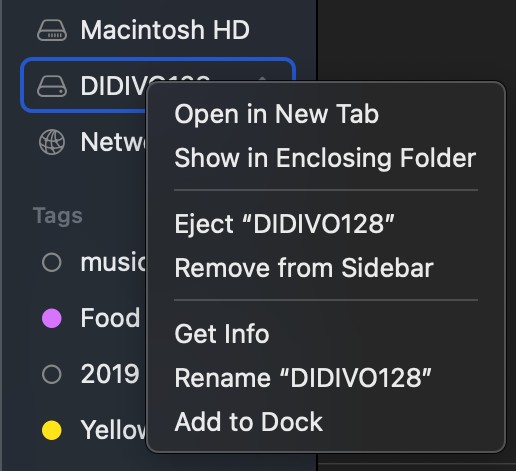Encrypting external USB drives on macOS can be a frustrating experience if the expected options are missing. Many users find themselves in a situation where they cannot encrypt their drives using the standard methods outlined in Apple’s documentation. This article explores a common reason behind this issue: the partition scheme of the drive. Specifically, A Guid Partition Table Scheme Is Required for enabling encryption features like APFS formatting and FileVault.
The user initially attempted to encrypt an external USB drive using two common methods:
- Right-clicking the drive in Finder and selecting “Encrypt”.
- Formatting the drive in Disk Utility with the APFS option and enabling encryption.
Neither of these options was available. The “Encrypt” option was missing from the Finder context menu, as shown below:
The user then tried formatting the drive using Disk Utility, expecting to find the APFS option. However, APFS was not available. They instead opted for Mac OS Extended (Journaled) and performed a 7-pass wipe. Even after this thorough formatting, the option to encrypt the drive remained unavailable.
After formatting as Mac OS Extended (Journaled), the “Convert to APFS” option appeared in Disk Utility. Attempting to convert resulted in the following error:
This error message points to the core issue: a GUID Partition Table scheme is required for APFS and, consequently, for enabling native macOS encryption features.
Understanding GUID Partition Table (GPT)
GPT is a standard for the layout of the partition table on a physical storage device, such as a hard drive or solid-state drive, using globally unique identifiers (GUIDs). It is part of the Unified Extensible Firmware Interface (UEFI) standard and is gradually replacing the older Master Boot Record (MBR) partitioning scheme.
Why is GPT Required for APFS and Encryption?
APFS (Apple File System) is Apple’s modern file system designed for SSDs and flash storage. It offers features like encryption, copy-on-write metadata, space sharing, and snapshots. APFS relies on the GPT partitioning scheme for its advanced features, including encryption. The older MBR scheme lacks the necessary features and flexibility to support APFS fully. Therefore, to utilize APFS encryption, a GUID Partition Table scheme is required.
How to Change to GUID Partition Table
To resolve this issue, you need to reformat the drive with the GUID Partition Map scheme. Here’s how:
- Open Disk Utility: Find it in
/Applications/Utilities. - Select the Drive: Choose the external drive from the sidebar. Important: Select the physical drive, not the volume underneath it.
- Erase: Click the “Erase” button in the toolbar.
- Name: Enter a name for the drive.
- Scheme: This is the crucial step. Click on the “Scheme” dropdown menu and select “GUID Partition Map”.
- Format: Choose a format. If you want to use APFS encryption, select “APFS”. If you choose another format like “Mac OS Extended (Journaled),” you can later convert to APFS.
- Erase: Click “Erase” to start the formatting process.
Warning: This process will erase all data on the drive. Ensure you have backed up any important files before proceeding.
After formatting the drive with the GUID Partition Map scheme, you should now be able to format it as APFS and enable encryption either during the formatting process or later by right-clicking the drive in Finder.
By ensuring that a GUID Partition Table scheme is required, you can unlock the encryption capabilities of macOS and protect your data on external drives. If the encryption option is still missing, double-check that the drive is indeed formatted as APFS and that FileVault is enabled in System Preferences > Security & Privacy.

